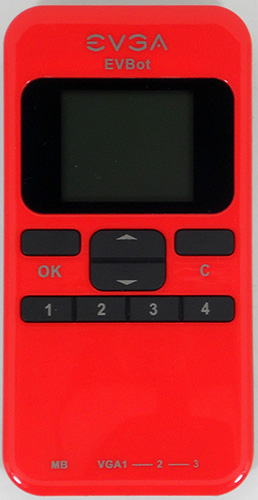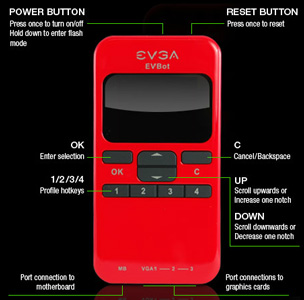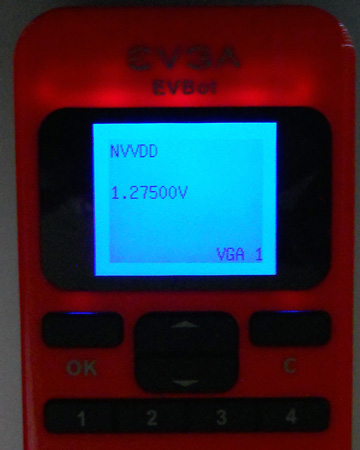EVGA GeForce GTX 680 Classified Review: Pushing GTX 680 To Its Peak
by Ryan Smith on July 20, 2012 12:00 PM ESTOvervolting & The EVGA EVBot
So much of the GTX 680 Classified is geared around overvolting, so we wanted to break this out into its own section.
For some time now NVIIDA has kept a tight leash on their partners' designs, with partners required to clear their designs with NVIDIA before they can sell them. NVIDIA’s interest in this matter is that video card manufacturing is a true partnership – their name and brand is at stake as much as the partners – so they want to be sure that GeForce cards meet their standards. This includes cooling, build quality, and noise limits (the reason the GTX 680C is limited to 55% fan speed). NVIDIA doesn’t publish what those requirements are so we can only speculate from the outside about what’s going on, but clearly NVIDIA has been unhappy with some partners’ custom designs in the past.
With the GeForce 600 series things have become a bit harder for NVIDIA’s partners. As we briefly mentioned before, NVIDIA is shying away from hardcore overclocking with the GeForce 600 series. Specifically, there are two things going on:
- Partners wishing to have a card with a TDP over 195W (i.e. a base power target 170W) must use a custom board with suitable power circuitry. NVIDIA won’t allow partners to ship higher-power cards using the reference board.
- Software overvoltage control is forbidden.
These rules impact two classes of cards. The first are heavily factory overclocked cards using the reference PCB, which goosed the GPU voltage to hit their high factory overclocks. Partners that wish to ship heavily overclocked cards will now need to bin to stay within NVIDIA’s power requirements. Meanwhile the second class of cards impacted is of course overclocking-focused cards like the GTX 680 Classified. Voltage control becomes necessary beyond a certain point, and since NVIDIA is requiring custom PCBs and disallowing software voltage control EVGA had to get creative.
The end result of that creativity is that EVGA has fallen back to their EVBot controller. By using a beefed up PCB along with an external controller, EVGA can offer voltage control while meeting NVIDIA’s guidelines.

The problem with having to resort to this kind of creativity is that it is unquestionably a step back for enthusiasts. Truth be told we don’t mind the voltage lock on reference cards – letting users play with voltage control on cards that aren’t meant for it can definitely lead to problems (e.g. GTX 590). However lack of software voltage control makes the whole thing very messy, as we’ll see in a moment. No doubt NVIDIA has their reasons for going this route, but we don’t believe that anyone has benefitted from a lack of software voltage control on these premium overclocking cards. NVIDIA could and should do better here, since this is effectively an arbitrary restriction that offers no benefit on cards such as the GTX 680 Classified.
Moving on, before getting into the nitty-gritty of voltage control let’s quickly discuss EVGA’s EVBot.
EVBot
Introduced a few years ago, EVGA’s EVBot is a controller intended to offer external control and monitoring capabilities for EVGA’s high-end video cards and motherboards. The device itself is a simple controller with an almost iPod-like design, and contains a small firmware that tells the EVBot how to interact with various devices. The EVBot draws power from the device it’s controlling, meaning it’s basically just a small controller (in the electronics sense) with buttons and a backlit monochrome screen. Finally, 4 headers are found on the bottom, allowing one EVBot to control up to 1 motherboard plus 3 video cards.
Short of an EVGA motherboard or video card, EVBot includes everything else necessary to use it. EVGA includes 4 EVBot cables, so you can control up to the controller’s limit of 4 devices without hunting down any further parts. The 4ft long cables are rather generous, but if you have a large case (like we do) then you’ll want to make sure you have an opening for the cable fairly close to where you intend to keep the controller, as there’s not a ton of slack space to run it behind a full size tower.

Once powered up, the EVBot is pretty simple to navigate through. Depending on the device being controlled different functions become available, with motherboards in particular getting a full range of voltage and clock adjustments, along with hardware monitoring. Video cards on the other hand get a much smaller feature set; the functionality is limited to voltage adjustment. Which means that the EVBot needs to be used in concert with software utilities such as EVGA’s Precision X in order to actually overclock and to monitor that overclock.
Ultimately the functionality EVBot provides for the GTX 680 Classified is essential, but because all it can be used for is voltage control it’s not all that useful. If EVBot could offer full clock control so that you could load a clock and voltage profile at the same time it would be far more useful, and for that matter would be a good hardware analog to what the EVGA Precision X software does.
Finally, if you’re purchasing an EVBot you’ll want to make sure you’re purchasing it directly from EVGA. While EVGA uses a standard hardware interface for the EVBot, the device needs hardware-specific profiles to operate. EVBot’s firmware is upgradable, but only via motherboards, so if you have an earlier firmware then you’re not going to be able to upgrade it for the GTX 680 Classified if the only EVGA product you have is the card. At the same time owners with both an EVGA motherboard and a GTX 680 Classified will want to pay close attention to the EVBot’s firmware limitations – because the EVBot’s firmware is so small, it can only store a couple of profiles. The GTX 680 Classified firmware (P15) doesn’t hold profiles for EVGA’s X79 motherboards, for example.
Overvolting With EVBot
So how does overvolting with EVBot work? For better or worse it’s actually very simple.
EVBot exposes 5 settings on the GTX 680 Classified: NVVDD, FBVDD, PEXVDD1, PEXVDD2, and OCP. These control the GPU voltage, the RAM voltage, the PCIe voltage, and OverCurrent Protection respectively. As is typically the case for video card overclocking, it’s the GPU and RAM voltage that are going to be the important settings for most users.
| EVBot Function Table | ||
| Name | Function | |
| NVVDD | GPU Voltage | |
| FBVDD | Memory Voltage | |
| PEXVDD1 | PCIe Voltage #1 | |
| PEXVDD2 | PCIe Voltage #2 | |
| OCP | OverCurrent Protection | |
Overvolting is simply a matter of dialing in the desired voltage, in the usual 0.0625v increments we’ve come to expect on GTX 680 products. EVGA tells us that GPU voltages up to 1.3v are safe, but of course your mileage may vary and the ultimate goal is to reach the desired clockspeed on as little voltage as possible.

Note that once EVBot is used to take control of the GPU voltage, it overrides NVIDIA’s standard control mechanism and leaves you in full control of the voltage. This happens completely transparently to NVIDIA’s software, which means that any overclocking tools using the NVAPI (which is to say, all of them) will continue to report the voltage the drivers are asking for rather than the real voltage. This makes the voltage monitoring points on the GTX 680 Classified all the more important, since that’s the only way to get a real voltage reading once voltage control is used.
However this also means that voltages are decoupled from NVIDIA’s clock domains. Consequently the GTX 680 Classified will idle at a higher voltage, increasing the idle power consumption of the card. This isn’t a huge problem, but it is a tradeoff for overvolting.
On that note, it’s unfortunate that EVBot voltage settings are not fully persistent. They will survive a soft reboot, but if the card is fully powered down you’ll need to reset the desired voltages the next time the card is powered up. For anyone intending to use an overvolted card on a regular basis, this means you’ll need to keep an EVBot plugged in at all times so that you can reset the voltages. Note that this also effectively precludes having EVGA Precision X or other utilities apply an overclock on startup, since you’ll want to set the voltage first before turning up the clockspeeds.
With all of that said, at the end of the day the EVBot does its job well enough given the limitations imposed by NVIDIA. The fact that this is a separate purchase on top of the GTX 680 Classified is unfortunate, but after thinking it through it wouldn’t make a ton of sense to include the EVBot with the card since all anyone would ever need is the one EVBot. Still, the $80 price tag on top of the $660 card means that GTX 680 overvolting is not for the thrifty at this time.















75 Comments
View All Comments
plonk420 - Saturday, July 21, 2012 - link
i'm kinda more interested in 8xMSAA or 4xSSAA...Ryan Smith - Saturday, July 21, 2012 - link
Ahh, okay, I see what you mean.So the short answer is that the memory requirements on Ultra are so high that we wouldn't be able to test most of our previous-generation 1GB cards at 1920 if we used it. I did want to have Ultra in there somewhere so that was the compromise I had to make to balance that with the need for a useful test at 1920.
Though I will agree that it's unorthodox.
RussianSensation - Saturday, July 21, 2012 - link
At the same time that would be pretty useful to see if GTX570/580 run out of VRAM in Shogun with Ultra settings at 1080P. What if GTX660Ti only has 1.5GB of VRAM? We'd want to know if it's already starting to become a bare minimum in games :)CeriseCogburn - Tuesday, July 24, 2012 - link
The 570 and 580 don't run out, but the 5750, 5870, and 6950 1gb and 6970 1gb do. A lot of amd fans have those 1gb cards because as usual, the amd fan is all about scrimping pennies and claiming they have the best anyway. Sad, isn't it.Sadder is the 1920x1200 rez they use here, which allows crap amd cards to lose by less when most people have 1920x1080 where nVidia stomps on amd ever harder, because as usual, amd fan boys are hacking away over pennies and buy the much cheaper and far more common 1920x1080 monitors instead of 1920x1200, saving $50 minimum amd more like $100+.
So, amd loses, all around, again, as usual.
Sabresiberian - Sunday, July 22, 2012 - link
There is no "1200p"Catch-phrases like "720p" and "1080p" refer to television formats; they aren't just the vertical pixel number. 1920x1200 is not a television standard, and the "p" is superfluous.
;)
LtGoonRush - Friday, July 20, 2012 - link
While EVGA's cooler is an improvement over stock, I wonder how a capable card like this would perform if paired with an high performance cooler like the Arctic Accelero Xtreme III. Kepler-based cards drop their boost clocks above 70C to compensate for increased leakage, so it would be interesting to see how fast this card could get while staying below that mark. Even at maximum RPMs the fans would probably be quieter than this one.pandemonium - Saturday, July 21, 2012 - link
I can't understand where the market for this card is. Wait, nevermind. I forgot how many nVidia fanbois there are out there...RussianSensation - Saturday, July 21, 2012 - link
So true. $740 GTX680 with a volt-mod kit vs. $450 HD7970 that overclocks on stock voltage to 1.175V and gives the same performance. NV marketing machine FTW!CeriseCogburn - Tuesday, July 24, 2012 - link
Amd cards never give the same performance as they lack so many features.you can perhaps, if you're lucky, get an fps only equivlanet in a few old games, or a hacked equivalent with crappy IQ that I'm sure you cannot see anyway, and in that case your power/performance is a big fat loser too - we cannot suddenly forget that for just this latest round when it was the most important point ever made for several years just prior now can we...
pffffft !~
ypsylon - Saturday, July 21, 2012 - link
Not with this card. When you buy reference for liquid cooling then you can't go wrong with EVGA. Best cards around. When you buy EVGA Hydrocopper - you can't go wrong. But EVGA Classified are usually only highly overpriced reference designs. Yes there are tweaks here and there, but for max performance [air cooler] out of GTX family most people [including my humble person] go to MSI TwinFrozr3 Lighting/EX.or Asus 3 slot bricks (name escapes me).Lately EVGA sliding with theirs top offerings. SR-X motherboard is cruel joke when compared to ASUS dual CPU creation and now this. Another misfire.
But I think EVGA doesn't care too much. They have devoted customers who buy everything EVGA without thinking...